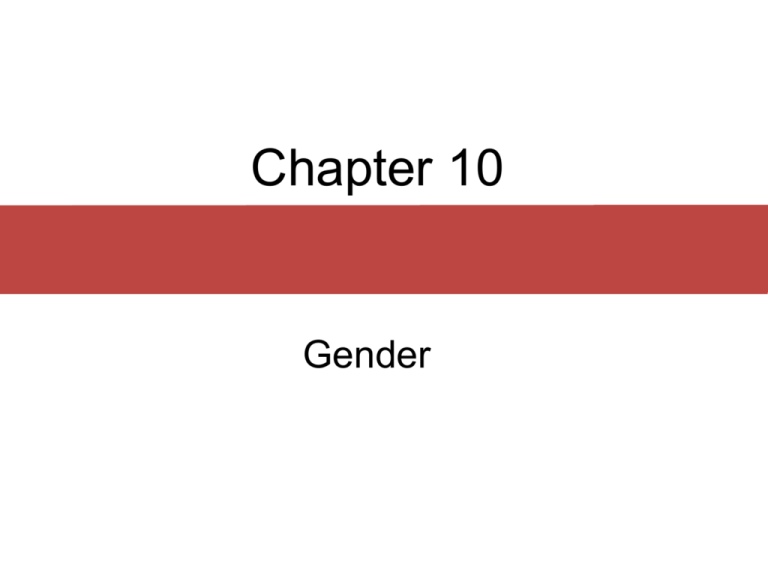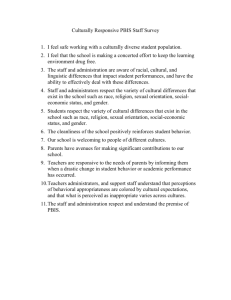
Chapter 10
Gender
Chapter Outline
Sex and Gender
Cultural Variation in Sexual Behavior
Coming of Age in Cross-Cultural Perspective:
Male and Female Rites of Passage
Gender Roles, Power, and Prestige: The
Status of Women
Gender Relations: Complex and Variable
Sex and Gender
Sex
The biological differences between male and
female.
Gender
The social classification of masculine and
feminine.
Margaret Mead
Masculine and feminine traits are patterned
by culture.
Key findings in new guinea:
– Arapesh: both sexes are expected to act in
ways Americans consider “feminine”.
– Mundugamor: both sexes were what
American culture would call “masculine”.
Cultural Construction of Gender
The idea that gender characteristics are not
inborn but rather constructed within each
culture.
All cultures recognize:
– Two sexes: male and female.
– Two genders: masculine and feminine.
Alternative Gender Roles
Genders that are neither man nor woman
have been described for many societies:
– Two-spirit—a man living as a woman and
considered to have supernatural powers in
native American society.
– Hijra—an alternative gender role in India
conceptualized as neither man nor woman.
Question
To say that gender is "constructed" is to say that
a) most cultures have few expectations about
behavior as it relates to gender.
b) masculine and feminine have different meanings
(and associated behaviors) in different cultures.
c) gender differences are actually superficial, given
other concerns of people's lifeways.
d) in American society, people are free to decide on
assuming any gender characteristics they wish.
e) societies have consciously developed ideas of
two or more genders in planning their way of life.
Answer: b
To say that gender is "constructed" is to say
that masculine and feminine have different
meanings (and associated behaviors) in
different cultures.
Cultural Sexual Behaviors
Cultures vary in what is erotic:
Before the Tahitians learned to kiss from the
Europeans, they began sexual intimacy by
sniffing.
The Trobriand islanders inspected each other
for lice if they felt fond of each other.
Homosexuality and Culture
Adolescent boys in Sambia have homosexual
relations as part of initiation but enter
heterosexual marriages as adults.
In the United States, consistent
heterosexuality is considered essential to
masculine identity.
Sexuality and Culture
Sexual norms affect sexual behavior.
Cultures differ in:
– Age that sexuality begins and ends.
– Ways people make themselves attractive.
– Importance of sexual activity.
Inis Beag Society: Ireland
Described as “one of the most sexually naïve
of the world’s societies”.
Women are expected to endure sex.
Refusing intercourse is a mortal sin.
Inis Beag Society
Culturally patterned sexual repression:
Absence of sexual foreplay.
Belief that sexual activity weakens men.
Absence of premarital sex.
High percentage of celibate males.
Extraordinarily late age of marriage.
Mangaia of Polynesia
Adolescent boys are given sexual instruction
and an experience with a woman in the
village.
Practically every girl and boy has had
intercourse before marriage.
Female frigidity, male celibacy, and
homosexuality are practically unknown.
Question
Anthropological studies of sexual behavior in
Mangaia, Polynesia and Inis Beag, Ireland, supports
which of the following statements?
a) Sexual behaviors are similar across cultures, as
shown in the two ethnographic cases.
b) Elders in Inis Beag are much more prone to
explain about sex than in Mangaia.
c) Both societies try to prevent young people from
having sexual intercourse until they are married.
d) Sexual activity and sexual responsiveness are
culturally-patterned.
e) Sexual jokes were more pronounced in Inis Beag
than Mangaia.
Answer: d
Anthropological studies of sexual behavior in
Mangaia, Polynesia and Inis Beag, Ireland,
supports the following statement:
– Sexual activity and sexual
responsiveness are culturallypatterned.
Male Initiation Rites: Purpose
Culturally validate male dominance.
Legitimate a change of status from child to
adult.
Involve an extended period of separation,
during which the initiates learn the beliefs,
skills, and knowledge necessary to participate
as a functioning adult in society.
Female Initiation Rites
Generally performed at menarche (first
menstruation).
Occur in more societies than male initiation rites.
Research indicates much cross-cultural variability.
– Sometimes the initiate is isolated from society;
sometimes she is the center of attention.
– Some rituals are elaborate and take years to
perform; others are performed with little ceremony.
Andalusia and
Sexual Control of Women
Women are seen as the devil.
Women have lustful appetites and lead men
into temptation.
Women possess goodness only as mothers.
Husbands fear that women drive them to
early death by demands for sex.
Manhood Puzzle
The question of why in almost all cultures
masculinity is viewed not as a natural state
but as a problematic status to be won through
overcoming obstacles.
Machismo
– A cultural construction of hypermasculinity
as essential to the male gender role.
Gender Roles
Cultural expectations of men and women in a
particular society, including the division of
labor.
Gender hierarchy
– The ways gendered activities and
attributes are related to the distribution of
resources, prestige, and power in a society.
Private/public Dichotomy
Gender system in which women’s status is
lowered by their cultural identification with the
home and children,
Men are identified with public, prestigious
economic and political roles.
Tlingit of the Northwest Coast
Gender relations are egalitarian.
Women and men could achieve prestige
through their own efforts.
Sexual division of labor was not rigid.
Women often acted as negotiators and
handled the money for long-distance trade.
Tlingit of the Northwest Coast
Some women were heads of clans or tribes.
Ideal marriage was between a man and
woman of equal rank.
Roles were structured based on ability,
training, and personality rather than gender.
Gender Relations in Horticultural
Societies
High degree of segregation between the
sexes.
Myths “explain” why women are socially
inferior to men and why men and
women have different roles.
Quick Quiz
1. Which one of the following does not describe
anthropologists' involvement in studies of gender?
a) documenting variation in how particular cultures
think about and symbolize gender
b) examination of evolutionary and historical
changes in gender relations
c) an interest in the effects of European expansion
on gender relationships in non-western societies
d) an almost exclusive focus on women, children,
and issues specific to women's lives
e) examination of how gender relations interrelate
with other aspects of a society and culture
Answer : d
The the following does not describe
anthropologists' involvement in studies of
gender:
– an almost exclusive focus on women,
children, and issues specific to
women's lives
2. Anthropologists refer to the observation that
in nearly all world cultures men test and
prove their manhood as
a) the androgyny perplex.
b) the "manhood puzzle.”
c) androcentrism.
d) initiation.
e) the public/private dichotomy.
Answer : b
Anthropologists refer to the observation that
in nearly all world cultures men test and
prove their manhood as the "manhood
puzzle.”
3. Women's role in the economy of a society
a) may be improved by the introduction of
new technology.
b) often changes, so that they have more
leisure time to spend with their children.
c) is often underestimated, so that their
status declines if machine technology is
added.
d) improves with technology and with being
paid in cash for their hard work.
e) may diminish as men take wage-labor
jobs.
Answer : c
Women's role in the economy of a society is
often underestimated, so that their status
declines if machine technology is added.







